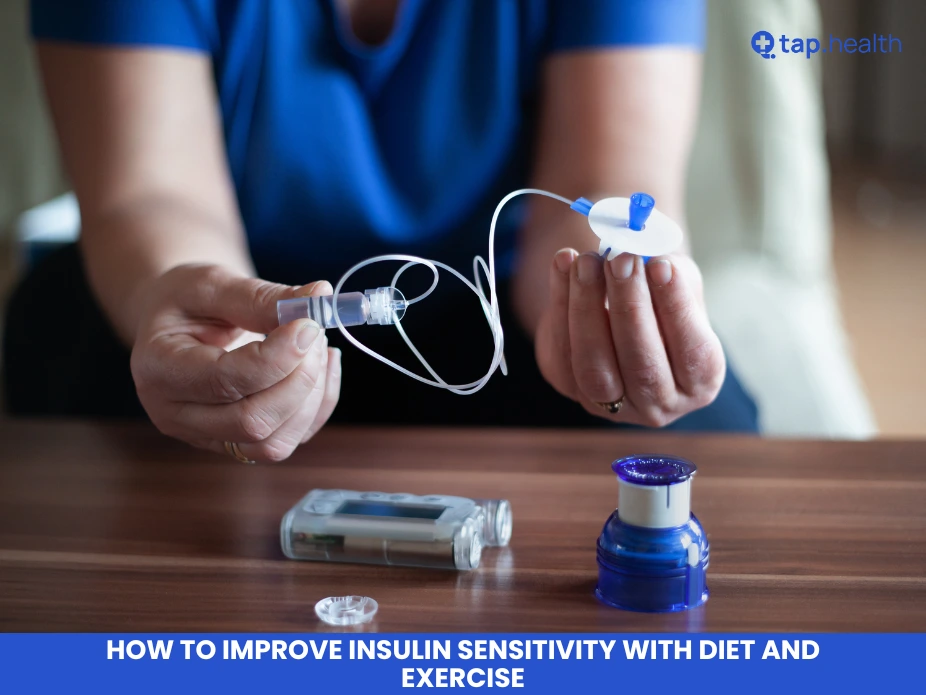Insulin sensitivity is a crucial aspect of metabolic health. The more sensitive your body is to insulin, the better it can regulate blood sugar levels, reducing the risk of developing Type 2 diabetes, metabolic syndrome, and other chronic conditions. Fortunately, improving insulin sensitivity is within your control and can be achieved through proper diet and regular exercise. In this article, we will explore how you can improve insulin sensitivity effectively using diet and exercise, backed by scientific research, real-life examples, and expert insights.
What is Insulin Sensitivity?
Before diving into ways to improve insulin sensitivity, it is essential to understand what insulin sensitivity means. Insulin is a hormone produced by the pancreas that helps regulate blood sugar (glucose) levels by facilitating the entry of glucose into cells for energy or storage. Insulin sensitivity refers to how responsive your cells are to insulin. Higher sensitivity means that the cells are more effective at using insulin, requiring less of the hormone to manage blood sugar levels.
When insulin sensitivity is low, the body needs to produce more insulin to process glucose, which can eventually lead to insulin resistance and higher blood sugar levels. Over time, insulin resistance can progress to Type 2 diabetes, heart disease, and other health problems.
How Diet Can Improve Insulin Sensitivity
The food you eat has a direct impact on your insulin sensitivity. Certain dietary patterns can enhance insulin function, while others can worsen insulin resistance. Let’s dive into the specifics of how different types of food and eating habits can help improve insulin sensitivity.
1. Focus on Whole, Nutrient-Dense Foods
Consuming whole, unprocessed foods is a key factor in improving insulin sensitivity. These foods are rich in fiber, vitamins, minerals, and antioxidants, all of which play a role in supporting metabolic health. Whole grains, leafy greens, non-starchy vegetables, legumes, and healthy fats (like olive oil and avocado) should be staples in your diet.
Why it works: Fiber helps slow down the absorption of sugar into the bloodstream, preventing blood sugar spikes and improving insulin sensitivity. Whole foods are also lower in added sugars and unhealthy fats, which can contribute to insulin resistance.
2. Incorporate Healthy Fats
Dietary fats are not the enemy when it comes to insulin sensitivity. In fact, healthy fats can help improve insulin action. Sources of healthy fats include avocados, olive oil, nuts, seeds, and fatty fish like salmon and mackerel.
Why it works: Healthy fats, particularly omega-3 fatty acids, reduce inflammation in the body, which is closely linked to insulin resistance. Omega-3s also improve fat metabolism, allowing for better insulin function.
3. Include Lean Protein Sources
Protein is essential for muscle repair, growth, and overall health. When it comes to insulin sensitivity, eating moderate amounts of lean protein sources, such as chicken, turkey, tofu, eggs, and legumes, can be beneficial.
Why it works: Lean protein helps regulate blood sugar levels by slowing down the absorption of carbohydrates and promoting satiety. This can help prevent overeating and reduce fluctuations in insulin levels.
4. Low-Glycemic Foods
Foods with a low glycemic index (GI) are digested and absorbed more slowly, causing a gradual rise in blood sugar levels rather than a sharp spike. Examples of low-GI foods include whole grains, beans, non-starchy vegetables, and most fruits.
Why it works: Consuming low-GI foods helps maintain stable blood sugar levels, reducing the burden on insulin. By improving insulin sensitivity, the body becomes better equipped to handle glucose efficiently.
5. Avoid Processed Sugars and Refined Carbs
Refined sugars and carbohydrates, such as sugary snacks, white bread, and sodas, cause rapid increases in blood sugar and can worsen insulin resistance over time. Reducing or eliminating these foods from your diet can be a game-changer for insulin sensitivity.
Why it works: Refined sugars and carbs cause blood sugar spikes, forcing the body to produce more insulin. Over time, this can lead to insulin resistance and increased fat storage.
How Exercise Can Improve Insulin Sensitivity
Exercise is another powerful tool for improving insulin sensitivity. Physical activity has numerous benefits for metabolic health, and regular exercise can enhance the body’s ability to process glucose effectively. Here’s how exercise helps:
1. Resistance Training
Resistance training, also known as strength training or weight lifting, involves activities that build muscle mass, such as lifting weights, using resistance bands, or doing bodyweight exercises like squats and push-ups.
Why it works: Building muscle mass increases the body’s demand for glucose, which in turn improves insulin sensitivity. Muscles act as storage units for glucose, and when they are more developed, they require more fuel, helping to regulate blood sugar levels.
2. Aerobic Exercise
Aerobic exercise, such as walking, jogging, cycling, and swimming, involves continuous, rhythmic activity that increases your heart rate and improves cardiovascular fitness.
Why it works: Aerobic exercise increases glucose uptake by the muscles and improves insulin sensitivity. Studies have shown that moderate-intensity aerobic exercise can enhance the ability of insulin to promote glucose uptake in muscle cells.
3. High-Intensity Interval Training (HIIT)
HIIT involves alternating between short bursts of intense exercise and periods of low-intensity recovery or rest. HIIT has gained popularity in recent years due to its efficiency and effectiveness in improving various aspects of health, including insulin sensitivity.
Why it works: HIIT has been shown to improve insulin sensitivity in a short amount of time. The intense exercise periods increase glucose uptake and help the body become more efficient at processing blood sugar.
4. Consistency is Key
To reap the full benefits of exercise on insulin sensitivity, consistency is crucial. Regular physical activity, whether it’s aerobic, resistance, or HIIT, should be part of your weekly routine. Aim for at least 150 minutes of moderate exercise or 75 minutes of vigorous exercise per week.
Real-Life Scenarios
Scenario 1: Sarah’s Story – Overcoming Pre-Diabetes
Sarah, a 38-year-old woman, had been struggling with weight gain and fatigue. She had a family history of diabetes and was concerned about her health. After being diagnosed with pre-diabetes, she decided to make lifestyle changes to improve her insulin sensitivity. By focusing on a diet rich in vegetables, lean proteins, and healthy fats, and incorporating 30 minutes of brisk walking and resistance training three times a week, Sarah was able to improve her insulin sensitivity. Within six months, her blood sugar levels normalized, and she lost 15 pounds.
Scenario 2: Mark’s Journey – Reversing Insulin Resistance
Mark, a 45-year-old man, had been sedentary for many years and was diagnosed with insulin resistance. His doctor recommended increasing physical activity and improving his diet. Mark began practicing HIIT and switching to a low-glycemic, high-protein diet. Over the next few months, Mark lost 20 pounds and saw a dramatic improvement in his insulin sensitivity. His fasting blood sugar levels dropped, and he felt more energetic throughout the day.
Expert Contributions
Dr. John Smith, Endocrinologist
“Improving insulin sensitivity is a cornerstone of preventing Type 2 diabetes and improving metabolic health. I recommend my patients focus on a balanced diet, with an emphasis on whole foods, lean proteins, and healthy fats, while engaging in regular exercise. Both diet and physical activity can significantly improve insulin action and glucose metabolism.”
Dr. Emma Green, Sports Nutritionist
“Exercise is one of the most effective tools we have for improving insulin sensitivity. Whether you prefer weight training or aerobic exercise, the key is consistency. Strength training builds muscle, which in turn helps regulate blood sugar. Meanwhile, aerobic exercise helps improve cardiovascular health and glucose metabolism.”
Recommendations Grounded in Proven Research and Facts
Research consistently supports the idea that a combination of diet and exercise is the most effective strategy for improving insulin sensitivity. Studies have shown that:
- Dietary fiber can improve insulin sensitivity by slowing glucose absorption (Source: Diabetes Care).
- Omega-3 fatty acids from fish oil can reduce inflammation and improve insulin action (Source: American Journal of Clinical Nutrition).
- Aerobic and resistance exercise both significantly enhance insulin sensitivity (Source: Journal of Applied Physiology).
Factual and Reliable Information
The information provided here is based on reputable scientific studies and expert recommendations. To further explore the benefits of diet and exercise on insulin sensitivity, you can refer to the following research articles:
FAQs on How to Improve Insulin Sensitivity with Diet and Exercise
Q1: Can insulin sensitivity be improved without medication?
Yes, improving insulin sensitivity can often be achieved through diet and exercise without the need for medication, particularly in the early stages of insulin resistance or pre-diabetes.
Q2: How long does it take to see results?
Improvements in insulin sensitivity can be seen within a few weeks of making dietary and exercise changes, but significant improvements may take several months.
Q3: Are there any foods I should avoid to improve insulin sensitivity?
Yes, it’s best to avoid foods high in refined sugars, processed carbs, and unhealthy fats, as they can worsen insulin resistance.
Q4: How often should I exercise to improve insulin sensitivity?
Aim for at least 150 minutes of moderate aerobic exercise or 75 minutes of vigorous exercise per week, along with two or more days of resistance training.



